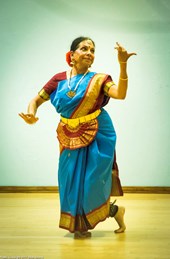Curriculum designed per individual skills and goals
Nritya Natyam Dance Academy
- Overland Park, KS
- Established Since 1996

“Sulekha /Trusted” indicates that the identity & information of the vendors/services, viz., name, address, contact details, business name has been verified on best effort basis, as existing, based on the documents/information furnished by the vendors/service providers. "Sulekha Trusted Stamp" are also allocated to the vendors/service providers considering user's reviews/ratings or any other criteria.
Sulekha strongly recommends to its users/callers to verify all relevant details of vendors/services before availing any products/services from them. Sulekha does not implicitly or explicitly endorse any product/s or services provided by the vendors/service providers.
The Sulekha Verified status confirms that a business's name, address, and contact details were accurate at the time of registration, based on submitted documents or call details. We recommend users exercise caution and conduct due diligence before using any services. Sulekha does not endorse any offerings from advertisers or service providers. For more information, please refer to our Terms and Conditions.

1996
Ketaki Ghanekar
“Bharatnatyam” is one of the most popular classical and traditional dances of India. It is inspired from the sculptures of the ancient temples of Chidambaram (Southern India). The origin of Bharartnatyam is in Thanjavoor of Tamilnadu (Southern Indian state). Bharatnatyam” is one of the eight classical dance forms. Indian classical dance at its heart is a form of story-telling and dates back at least 3000 years to the “Natya Shastra”, a book on theater, music and dance that continues to guide the art. It was performed in the temples as part of the worship of God and in the Royal courts to entertain the king and his guests. This art form was handed down as a living tradition from generation to generation under the "Devadasi" system in which women were dedicated to temples to serve the deity as dancers and musicians forming part of the elaborate rituals. This 3000 years, old dance form started losing some respect as a result of the colonization of the Indian subcontinent. “Bharatnatyam”, the most inherent part of the temple rituals began to deteriorate in terms of respect and divinity. In later years, several legendary women played a very significant role in bringing it back from its downfall. It was during the 1930’s that these people started preaching the beauty of this dance form to the elite. As a result of the efforts, “Bharatnatyam” was revived until it continued to be identified as epitome of class and grace. Today, it is popular on-stage, screen and television.

Salsa dancing is not just a dance; it’s a vibrant expression of culture, rhythm, and joy! Whether you’re a complete beginner...
Continue reading
Introduction to Indian Dance Indian dance
Continue reading
Dance is more than just movement; it's a celebration of culture, history, and tradition. For kids, learning folk dances prov...
Continue reading